Spring Security
Spring Security 是 Spring 社区的一个顶级项目,也是 Spring Boot 官方推荐使用的安全框架。除了常规的认证(Authentication)和授权(Authorization)之外,Spring Security还提供了诸如ACLs,LDAP,JAAS,CAS等高级特性以满足复杂场景下的安全需求。
Spring Security 应用级别的安全主要包含两个主要部分,即登录认证(Authentication)和访问授权(Authorization),首先用户登录的时候传入登录信息,登录验证器完成登录认证并将登录认证好的信息存储到请求上下文,然后在进行其他操作,如接口访问、方法调用时,权限认证器从上下文中获取登录认证信息,然后根据认证信息获取权限信息,通过权限信息和特定的授权策略决定是否授权。
接下来,本教程将分别对登录认证和访问授权的执行流程进行剖析,并在最后给出完整的案例实现,如果觉得先读前面原理比较难懂,可以先学习后面的实现案例,再结合案例理解登录认证和访问授权的执行原理。
登录认证
登录认证过滤器
如果在继承 WebSecurityConfigurerAdapter 的配置类中的 configure(HttpSecurity http) 方法中有配置 HttpSecurity 的 formLogin,则会返回一个 FormLoginConfigurer 对象。如下是一个 Spring Security 的配置样例, formLogin().x.x 就是配置使用内置的登录验证过滤器,默认实现为 UsernamePasswordAuthenticationFilter。
WebSecurityConfig.java

@Configuration
@EnableWebSecurity
@EnableGlobalMethodSecurity(prePostEnabled = true)
public class WebSecurityConfig extends WebSecurityConfigurerAdapter {
@Autowired
private UserDetailsService userDetailsService;
@Override
public void configure(AuthenticationManagerBuilder auth) throws Exception {
// 使用自定义身份验证组件
auth.authenticationProvider(new JwtAuthenticationProvider(userDetailsService));
}
@Override
protected void configure(HttpSecurity http) throws Exception {
http.cors().and().csrf().disable()
.authorizeRequests()
// 首页和登录页面
.antMatchers("/").permitAll()
// 其他所有请求需要身份认证
.anyRequest().authenticated()
// 配置登录认证
.and().formLogin().loginProcessingUrl("/login");
}
}

查看 HttpSecurity , formLogion 方法返回一个 FormLoginConfigurer 对象。
HttpSecurity.java
public FormLoginConfigurer<HttpSecurity> formLogin() throws Exception {
return getOrApply(new FormLoginConfigurer<>());
}
而 FormLoginConfigurer 的构造函数内绑定了一个 UsernamePasswordAuthenticationFilter 过滤器。
FormLoginConfigurer.java
public FormLoginConfigurer() {
super(new UsernamePasswordAuthenticationFilter(), null);
usernameParameter("username");
passwordParameter("password");
}
再看 UsernamePasswordAuthenticationFilter 过滤器的构造函数内绑定了 POST 类型的 /login 请求,也就是说,如果配置了 formLogin 的相关信息,那么在使用 POST 类型的 /login URL进行登录的时候就会被这个过滤器拦截,并进行登录验证,登录验证过程我们下面继续分析。
UsernamePasswordAuthenticationFilter.java
public UsernamePasswordAuthenticationFilter() {
super(new AntPathRequestMatcher("/login", "POST"));
}
查看 UsernamePasswordAuthenticationFilter,发现它继承了 AbstractAuthenticationProcessingFilter,AbstractAuthenticationProcessingFilter 中的 doFilter 包含了触发登录认证执行流程的相关逻辑。
AbstractAuthenticationProcessingFilter.java

public void doFilter(ServletRequest req, ServletResponse res, FilterChain chain)
throws IOException, ServletException {
...
Authentication authResult;
try {
authResult = attemptAuthentication(request, response);
if (authResult == null) {
// return immediately as subclass has indicated that it hasn't completed
// authentication
return;
}
sessionStrategy.onAuthentication(authResult, request, response);
}
...
successfulAuthentication(request, response, chain, authResult);
}

上面的登录逻辑主要步骤有两个:
1. attemptAuthentication(request, response)
这是 AbstractAuthenticationProcessingFilter 中的一个抽象方法,包含登录主逻辑,由其子类实现具体的登录验证,如 UsernamePasswordAuthenticationFilter 是使用表单方式登录的具体实现。如果是非表单登录的方式,如JNDI等其他方式登录的可以通过继承 AbstractAuthenticationProcessingFilter 自定义登录实现。UsernamePasswordAuthenticationFilter 的登录实现逻辑如下。
UsernamePasswordAuthenticationFilter.java

public Authentication attemptAuthentication(HttpServletRequest request, HttpServletResponse response) throws AuthenticationException {
if (postOnly && !request.getMethod().equals("POST")) {
throw new AuthenticationServiceException("Authentication method not supported: " + request.getMethod());
}
// 获取用户名和密码
String username = obtainUsername(request);
String password = obtainPassword(request);
if (username == null) {
username = "";
}
if (password == null) {
password = "";
}
username = username.trim();
UsernamePasswordAuthenticationToken authRequest = new UsernamePasswordAuthenticationToken(username, password);
// Allow subclasses to set the "details" property
setDetails(request, authRequest);
return this.getAuthenticationManager().authenticate(authRequest);
}

2. successfulAuthentication(HttpServletRequest request, HttpServletResponse response, FilterChain chain, Authentication authResult)
登录成功之后,将认证后的 Authentication 对象存储到请求线程上下文,这样在授权阶段就可以获取到 Authentication 认证信息,并利用 Authentication 内的权限信息进行访问控制判断。
AbstractAuthenticationProcessingFilter.java

protected void successfulAuthentication(HttpServletRequest request,
HttpServletResponse response, FilterChain chain, Authentication authResult)
throws IOException, ServletException {
if (logger.isDebugEnabled()) {
logger.debug("Authentication success. Updating SecurityContextHolder to contain: " + authResult);
}
// 登录成功之后,把认证后的 Authentication 对象存储到请求线程上下文,这样在授权阶段就可以获取到此认证信息进行访问控制判断
SecurityContextHolder.getContext().setAuthentication(authResult);
rememberMeServices.loginSuccess(request, response, authResult);
// Fire event
if (this.eventPublisher != null) {
eventPublisher.publishEvent(new InteractiveAuthenticationSuccessEvent(
authResult, this.getClass()));
}
successHandler.onAuthenticationSuccess(request, response, authResult);
}

从上面的登录逻辑我们可以看到,Spring Security的登录认证过程是委托给 AuthenticationManager 完成的,它先是解析出用户名和密码,然后把用户名和密码封装到一个UsernamePasswordAuthenticationToken 中,传递给 AuthenticationManager,交由 AuthenticationManager 完成实际的登录认证过程。
AuthenticationManager.java

package org.springframework.security.authentication;
import org.springframework.security.core.Authentication;
import org.springframework.security.core.AuthenticationException;
/**
* Processes an {@link Authentication} request.
* @author Ben Alex
*/
public interface AuthenticationManager {
Authentication authenticate(Authentication authentication) throws AuthenticationException;
}

AuthenticationManager 提供了一个默认的 实现 ProviderManager,而 ProviderManager 又将验证委托给了 AuthenticationProvider。
ProviderManager.java

public Authentication authenticate(Authentication authentication)
throws AuthenticationException {
... for (AuthenticationProvider provider : getProviders()) {
if (!provider.supports(toTest)) {
continue;
}try {
result = provider.authenticate(authentication);
if (result != null) {
copyDetails(authentication, result);
break;
}
} ...
}

根据验证方式的多样化,AuthenticationProvider 衍生出多种类型的实现,AbstractUserDetailsAuthenticationProvider 是 AuthenticationProvider 的抽象实现,定义了较为统一的验证逻辑,各种验证方式可以选择直接继承 AbstractUserDetailsAuthenticationProvider 完成登录认证,如 DaoAuthenticationProvider 就是继承了此抽象类,完成了从DAO方式获取验证需要的用户信息的。
AbstractUserDetailsAuthenticationProvider.java

public Authentication authenticate(Authentication authentication) throws AuthenticationException {// Determine username
String username = (authentication.getPrincipal() == null) ? "NONE_PROVIDED" : authentication.getName();
boolean cacheWasUsed = true;
UserDetails user = this.userCache.getUserFromCache(username);
if (user == null) {
cacheWasUsed = false;
try { // 子类根据自身情况从指定的地方加载认证需要的用户信息
user = retrieveUser(username, (UsernamePasswordAuthenticationToken) authentication);
}
...try { // 前置检查,一般是检查账号状态,如是否锁定之类
preAuthenticationChecks.check(user); // 进行一般逻辑认证,如 DaoAuthenticationProvider 实现中的密码验证就是在这里完成的
additionalAuthenticationChecks(user, (UsernamePasswordAuthenticationToken) authentication);
}
...
// 后置检查,如可以检查密码是否过期之类
postAuthenticationChecks.check(user);
... // 验证成功之后返回包含完整认证信息的 Authentication 对象
return createSuccessAuthentication(principalToReturn, authentication, user);
}

如上面所述, AuthenticationProvider 通过 retrieveUser(String username, UsernamePasswordAuthenticationToken authentication) 获取验证信息,对于我们一般所用的 DaoAuthenticationProvider 是由 UserDetailsService 专门负责获取验证信息的。
DaoAuthenticationProvider.java

protected final UserDetails retrieveUser(String username, UsernamePasswordAuthenticationToken authentication) throws AuthenticationException {
try {
UserDetails loadedUser = this.getUserDetailsService().loadUserByUsername(username);
if (loadedUser == null) {
throw new InternalAuthenticationServiceException("UserDetailsService returned null, which is an interface contract violation");
}
return loadedUser;
}
}

UserDetailsService 接口只有一个方法,loadUserByUsername(String username),一般需要我们实现此接口方法,根据用户名加载登录认证和访问授权所需要的信息,并返回一个 UserDetails的实现类,后面登录认证和访问授权都需要用到此中的信息。

public interface UserDetailsService {
/**
* Locates the user based on the username. In the actual implementation, the search
* may possibly be case sensitive, or case insensitive depending on how the
* implementation instance is configured. In this case, the <code>UserDetails</code>
* object that comes back may have a username that is of a different case than what
* was actually requested..
*
* @param username the username identifying the user whose data is required.
*
* @return a fully populated user record (never <code>null</code>)
*
* @throws UsernameNotFoundException if the user could not be found or the user has no
* GrantedAuthority
*/
UserDetails loadUserByUsername(String username) throws UsernameNotFoundException;
}

UserDetails 提供了一个默认实现 User,主要包含用户名(username)、密码(password)、权限(authorities)和一些账号或密码状态的标识。
如果默认实现满足不了你的需求,可以根据需求定制自己的 UserDetails,然后在 UserDetailsService 的 loadUserByUsername 中返回即可。

public class User implements UserDetails, CredentialsContainer {// ~ Instance fields
// ================================================================================================
private String password;
private final String username;
private final Set<GrantedAuthority> authorities;
private final boolean accountNonExpired;
private final boolean accountNonLocked;
private final boolean credentialsNonExpired;
private final boolean enabled;
// ~ Constructors
// ===================================================================================================
public User(String username, String password,
Collection<? extends GrantedAuthority> authorities) {
this(username, password, true, true, true, true, authorities);
} ...
}

退出登录
Spring Security 提供了一个默认的登出过滤器 LogoutFilter,默认拦截路径是 /logout,当访问 /logout 路径的时候,LogoutFilter 会进行退出处理。
LogoutFilter.java

package org.springframework.security.web.authentication.logout;
public class LogoutFilter extends GenericFilterBean {
// ~ Instance fields
// ================================================================================================
private RequestMatcher logoutRequestMatcher;
private final LogoutHandler handler;
private final LogoutSuccessHandler logoutSuccessHandler;
// ~ Constructors
// ===================================================================================================
public LogoutFilter(LogoutSuccessHandler logoutSuccessHandler,
LogoutHandler... handlers) {
this.handler = new CompositeLogoutHandler(handlers);
Assert.notNull(logoutSuccessHandler, "logoutSuccessHandler cannot be null");
this.logoutSuccessHandler = logoutSuccessHandler;
setFilterProcessesUrl("/logout"); // 绑定 /logout
}// ~ Methods
// ========================================================================================================
public void doFilter(ServletRequest req, ServletResponse res, FilterChain chain)
throws IOException, ServletException {
HttpServletRequest request = (HttpServletRequest) req;
HttpServletResponse response = (HttpServletResponse) res;
if (requiresLogout(request, response)) {
Authentication auth = SecurityContextHolder.getContext().getAuthentication();this.handler.logout(request, response, auth); // 登出处理,可能包含session、cookie、认证信息的清理工作
logoutSuccessHandler.onLogoutSuccess(request, response, auth); // 退出后的操作,可能是跳转、返回成功状态等
return;
}
chain.doFilter(request, response);
}
...
}

如下是 SecurityContextLogoutHandler 中的登出处理实现。
SecurityContextLogoutHandler.java

public void logout(HttpServletRequest request, HttpServletResponse response,
Authentication authentication) {
// 让 session 失效 if (invalidateHttpSession) {
HttpSession session = request.getSession(false);
if (session != null) {
logger.debug("Invalidating session: " + session.getId());
session.invalidate();
}
}
// 清理 Security 上下文,其中包含登录认证信息
if (clearAuthentication) {
SecurityContext context = SecurityContextHolder.getContext();
context.setAuthentication(null);
}
SecurityContextHolder.clearContext();
}

访问授权
访问授权主要分为两种:通过URL方式的接口访问控制和方法调用的权限控制。
接口访问权限
在通过比如浏览器使用URL访问后台接口时,是否允许访问此URL,就是接口访问权限。
在进行接口访问时,会由 FilterSecurityInterceptor 进行拦截并进行授权。
FilterSecurityInterceptor 继承了 AbstractSecurityInterceptor 并实现了 javax.servlet.Filter 接口, 所以在URL访问的时候都会被过滤器拦截,doFilter 实现如下。
FilterSecurityInterceptor.java
public void doFilter(ServletRequest request, ServletResponse response,
FilterChain chain) throws IOException, ServletException {
FilterInvocation fi = new FilterInvocation(request, response, chain);
invoke(fi);
}
doFilter 方法又调用了自身的 invoke 方法, invoke 方法又调用了父类 AbstractSecurityInterceptor 的 beforeInvocation 方法。
FilterSecurityInterceptor.java

public void invoke(FilterInvocation fi) throws IOException, ServletException {
if ((fi.getRequest() != null)
&& (fi.getRequest().getAttribute(FILTER_APPLIED) != null)
&& observeOncePerRequest) {
// filter already applied to this request and user wants us to observe
// once-per-request handling, so don't re-do security checking
fi.getChain().doFilter(fi.getRequest(), fi.getResponse());
}
else {
// first time this request being called, so perform security checking
if (fi.getRequest() != null && observeOncePerRequest) {
fi.getRequest().setAttribute(FILTER_APPLIED, Boolean.TRUE);
}
InterceptorStatusToken token = super.beforeInvocation(fi);
try {
fi.getChain().doFilter(fi.getRequest(), fi.getResponse());
}
finally {
super.finallyInvocation(token);
}
super.afterInvocation(token, null);
}
}

方法调用权限
在进行后台方法调用时,是否允许该方法调用,就是方法调用权限。比如在方法上添加了此类注解 @PreAuthorize("hasRole('ROLE_ADMIN')") ,Security 方法注解的支持需要在任何配置类中(如 WebSecurityConfigurerAdapter )添加 @EnableGlobalMethodSecurity(prePostEnabled = true) 开启,才能够使用。
@Configuration
@EnableWebSecurity
@EnableGlobalMethodSecurity(prePostEnabled = true)
public class WebSecurityConfig extends WebSecurityConfigurerAdapter {
}
在进行方法调用时,会由 MethodSecurityInterceptor 进行拦截并进行授权。
MethodSecurityInterceptor 继承了 AbstractSecurityInterceptor 并实现了AOP 的 org.aopalliance.intercept.MethodInterceptor 接口, 所以可以在方法调用时进行拦截。
MethodSecurityInterceptor .java

public Object invoke(MethodInvocation mi) throws Throwable {
InterceptorStatusToken token = super.beforeInvocation(mi);
Object result;
try {
result = mi.proceed();
}
finally {
super.finallyInvocation(token);
}
return super.afterInvocation(token, result);
}

我们看到,MethodSecurityInterceptor 跟 FilterSecurityInterceptor 一样, 都是通过调用父类 AbstractSecurityInterceptor 的相关方法完成授权,其中 beforeInvocation 是完成权限认证的关键。
AbstractSecurityInterceptor.java

protected InterceptorStatusToken beforeInvocation(Object object) {
...
// 通过 SecurityMetadataSource 获取权限配置信息,可以定制实现自己的权限信息获取逻辑
Collection<ConfigAttribute> attributes = this.obtainSecurityMetadataSource().getAttributes(object);
... // 确认是否经过登录认证
Authentication authenticated = authenticateIfRequired();
// Attempt authorization
try { // 通过 AccessDecisionManager 完成授权认证,默认实现是 AffirmativeBased
this.accessDecisionManager.decide(authenticated, object, attributes);
}
...
}

上面代码显示 AbstractSecurityInterceptor 又是委托授权认证器 AccessDecisionManager 完成授权认证,默认实现是 AffirmativeBased, decide 方法实现如下。
AffirmativeBased.java

public void decide(Authentication authentication, Object object,
Collection<ConfigAttribute> configAttributes) throws AccessDeniedException {
int deny = 0;
for (AccessDecisionVoter voter : getDecisionVoters()) { // 通过各种投票策略,最终决定是否授权
int result = voter.vote(authentication, object, configAttributes);
switch (result) {
case AccessDecisionVoter.ACCESS_GRANTED:
return;
case AccessDecisionVoter.ACCESS_DENIED:
deny++;
break;
default:
break;
}
...
}

而 AccessDecisionManager 决定授权又是通过一个授权策略集合(AccessDecisionVoter )决定的,授权决定的原则是:
1. 遍历所有授权策略, 如果有其中一个返回 ACCESS_GRANTED,则同意授权。
2. 否则,等待遍历结束,统计 ACCESS_DENIED 个数,只要拒绝数大于1,则不同意授权。
对于接口访问授权,也就是 FilterSecurityInterceptor 管理的URL授权,默认对应的授权策略只有一个,就是 WebExpressionVoter,它的授权策略主要是根据 WebSecurityConfigurerAdapter 内配置的路径访问策略进行匹配,然后决定是否授权。
WebExpressionVoter.java

/**
* Voter which handles web authorisation decisions.
* @author Luke Taylor
* @since 3.0
*/
public class WebExpressionVoter implements AccessDecisionVoter<FilterInvocation> {
private SecurityExpressionHandler<FilterInvocation> expressionHandler = new DefaultWebSecurityExpressionHandler();
public int vote(Authentication authentication, FilterInvocation fi,
Collection<ConfigAttribute> attributes) {
assert authentication != null;
assert fi != null;
assert attributes != null;
WebExpressionConfigAttribute weca = findConfigAttribute(attributes);
if (weca == null) {
return ACCESS_ABSTAIN;
}
EvaluationContext ctx = expressionHandler.createEvaluationContext(authentication, fi);
ctx = weca.postProcess(ctx, fi);
return ExpressionUtils.evaluateAsBoolean(weca.getAuthorizeExpression(), ctx) ? ACCESS_GRANTED : ACCESS_DENIED;
}
...
}

对于方法调用授权,在全局方法安全配置类里,可以看到给 MethodSecurityInterceptor 默认配置的有 RoleVoter、AuthenticatedVoter、Jsr250Voter、和 PreInvocationAuthorizationAdviceVoter,其中 Jsr250Voter、PreInvocationAuthorizationAdviceVoter 都需要打开指定的开关,才会添加支持。
GlobalMethodSecurityConfiguration.java

@Configuration
public class GlobalMethodSecurityConfiguration implements ImportAware, SmartInitializingSingleton {
...private MethodSecurityInterceptor methodSecurityInterceptor;
@Bean
public MethodInterceptor methodSecurityInterceptor() throws Exception {
this.methodSecurityInterceptor = isAspectJ()
? new AspectJMethodSecurityInterceptor()
: new MethodSecurityInterceptor();
methodSecurityInterceptor.setAccessDecisionManager(accessDecisionManager());
methodSecurityInterceptor.setAfterInvocationManager(afterInvocationManager());
methodSecurityInterceptor
.setSecurityMetadataSource(methodSecurityMetadataSource());
RunAsManager runAsManager = runAsManager();
if (runAsManager != null) {
methodSecurityInterceptor.setRunAsManager(runAsManager);
}
return this.methodSecurityInterceptor;
}
protected AccessDecisionManager accessDecisionManager() {
List<AccessDecisionVoter<? extends Object>> decisionVoters = new ArrayList<AccessDecisionVoter<? extends Object>>();
ExpressionBasedPreInvocationAdvice expressionAdvice = new ExpressionBasedPreInvocationAdvice();
expressionAdvice.setExpressionHandler(getExpressionHandler());
if (prePostEnabled()) {
decisionVoters
.add(new PreInvocationAuthorizationAdviceVoter(expressionAdvice));
}
if (jsr250Enabled()) {
decisionVoters.add(new Jsr250Voter());
}
decisionVoters.add(new RoleVoter());
decisionVoters.add(new AuthenticatedVoter());
return new AffirmativeBased(decisionVoters);
} ...}

RoleVoter 是根据角色进行匹配授权的策略。
RoleVoter.java

public class RoleVoter implements AccessDecisionVoter<Object> {
// RoleVoter 默认角色名以 "ROLE_" 为前缀。
private String rolePrefix = "ROLE_";public boolean supports(ConfigAttribute attribute) {
if ((attribute.getAttribute() != null)
&& attribute.getAttribute().startsWith(getRolePrefix())) {
return true;
}
else {
return false;
}
}public int vote(Authentication authentication, Object object,
Collection<ConfigAttribute> attributes) {
if(authentication == null) {
return ACCESS_DENIED;
}
int result = ACCESS_ABSTAIN;
Collection<? extends GrantedAuthority> authorities = extractAuthorities(authentication);
// 逐个角色进行匹配,入股有一个匹配得上,则进行授权
for (ConfigAttribute attribute : attributes) {
if (this.supports(attribute)) {
result = ACCESS_DENIED;
// Attempt to find a matching granted authority
for (GrantedAuthority authority : authorities) {
if (attribute.getAttribute().equals(authority.getAuthority())) {
return ACCESS_GRANTED;
}
}
}
}
return result;
}
Collection<? extends GrantedAuthority> extractAuthorities(Authentication authentication) {
return authentication.getAuthorities();
}
}

AuthenticatedVoter 主要是针对有配置以下几个属性来决定授权的策略。
IS_AUTHENTICATED_REMEMBERED:记住我登录状态
IS_AUTHENTICATED_ANONYMOUSLY:匿名认证状态
IS_AUTHENTICATED_FULLY: 完全登录状态,即非上面两种类型
AuthenticatedVoter.java

public int vote(Authentication authentication, Object object,
Collection<ConfigAttribute> attributes) {
int result = ACCESS_ABSTAIN;
for (ConfigAttribute attribute : attributes) {
if (this.supports(attribute)) {
result = ACCESS_DENIED;
// 完全登录状态
if (IS_AUTHENTICATED_FULLY.equals(attribute.getAttribute())) {
if (isFullyAuthenticated(authentication)) {
return ACCESS_GRANTED;
}
}
// 记住我登录状态
if (IS_AUTHENTICATED_REMEMBERED.equals(attribute.getAttribute())) {
if (authenticationTrustResolver.isRememberMe(authentication)
|| isFullyAuthenticated(authentication)) {
return ACCESS_GRANTED;
}
}
// 匿名登录状态
if (IS_AUTHENTICATED_ANONYMOUSLY.equals(attribute.getAttribute())) {
if (authenticationTrustResolver.isAnonymous(authentication)
|| isFullyAuthenticated(authentication)
|| authenticationTrustResolver.isRememberMe(authentication)) {
return ACCESS_GRANTED;
}
}
}
}
return result;
}

PreInvocationAuthorizationAdviceVoter 是针对类似 @PreAuthorize("hasRole('ROLE_ADMIN')") 注解解析并进行授权的策略。
PreInvocationAuthorizationAdviceVoter.java

public class PreInvocationAuthorizationAdviceVoter implements AccessDecisionVoter<MethodInvocation> {private final PreInvocationAuthorizationAdvice preAdvice;
public int vote(Authentication authentication, MethodInvocation method,
Collection<ConfigAttribute> attributes) {
PreInvocationAttribute preAttr = findPreInvocationAttribute(attributes);
if (preAttr == null) {
// No expression based metadata, so abstain
return ACCESS_ABSTAIN;
}
boolean allowed = preAdvice.before(authentication, method, preAttr);
return allowed ? ACCESS_GRANTED : ACCESS_DENIED;
}
private PreInvocationAttribute findPreInvocationAttribute(
Collection<ConfigAttribute> config) {
for (ConfigAttribute attribute : config) {
if (attribute instanceof PreInvocationAttribute) {
return (PreInvocationAttribute) attribute;
}
}
return null;
}
}

PreInvocationAuthorizationAdviceVoter 解析出注解属性配置, 然后通过调用 PreInvocationAuthorizationAdvice 的前置通知方法进行授权认证,默认实现类似 ExpressionBasedPreInvocationAdvice,通知内主要进行了内容的过滤和权限表达式的匹配。
ExpressionBasedPreInvocationAdvice.java

public class ExpressionBasedPreInvocationAdvice implements PreInvocationAuthorizationAdvice {
private MethodSecurityExpressionHandler expressionHandler = new DefaultMethodSecurityExpressionHandler();
public boolean before(Authentication authentication, MethodInvocation mi, PreInvocationAttribute attr) {
PreInvocationExpressionAttribute preAttr = (PreInvocationExpressionAttribute) attr;
EvaluationContext ctx = expressionHandler.createEvaluationContext(authentication, mi);
Expression preFilter = preAttr.getFilterExpression();
Expression preAuthorize = preAttr.getAuthorizeExpression();
if (preFilter != null) {
Object filterTarget = findFilterTarget(preAttr.getFilterTarget(), ctx, mi);
expressionHandler.filter(filterTarget, preFilter, ctx);
}
if (preAuthorize == null) {
return true;
}
return ExpressionUtils.evaluateAsBoolean(preAuthorize, ctx);
}
...
}

案例实现
接下来,我们以一个实现案例来进行说明讲解。
新建工程
新建一个 Spring Boot 项目 springboot-spring-security。
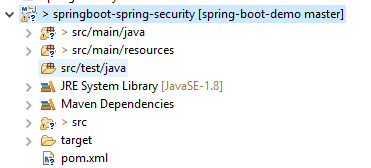
添加依赖
添加项目依赖,主要是 Spring Security 和 JWT,另外添加 Swagger 和 fastjson 作为辅助工具。
pom.xml

<?xml version="1.0" encoding="UTF-8"?>
<project xmlns="http://maven.apache.org/POM/4.0.0" xmlns:xsi="http://www.w3.org/2001/XMLSchema-instance"
xsi:schemaLocation="http://maven.apache.org/POM/4.0.0 http://maven.apache.org/xsd/maven-4.0.0.xsd">
<modelVersion>4.0.0</modelVersion>
<groupId>top.ivan.demo</groupId>
<artifactId>springboot-spring-security</artifactId>
<version>0.0.1-SNAPSHOT</version>
<packaging>jar</packaging>
<name>springboot-spring-security</name>
<description>Demo project for Spring Boot</description>
<parent>
<groupId>org.springframework.boot</groupId>
<artifactId>spring-boot-starter-parent</artifactId>
<version>2.0.4.RELEASE</version>
<relativePath/> <!-- lookup parent from repository -->
</parent>
<properties>
<project.build.sourceEncoding>UTF-8</project.build.sourceEncoding>
<project.reporting.outputEncoding>UTF-8</project.reporting.outputEncoding>
<java.version>1.8</java.version>
<mybatis.spring.version>1.3.2</mybatis.spring.version>
<swagger.version>2.8.0</swagger.version>
<jwt.version>0.9.1</jwt.version>
<fastjson.version>1.2.48</fastjson.version>
</properties>
<dependencies>
<!-- spring boot -->
<dependency>
<groupId>org.springframework.boot</groupId>
<artifactId>spring-boot-starter-web</artifactId>
</dependency>
<dependency>
<groupId>org.springframework.boot</groupId>
<artifactId>spring-boot-starter-test</artifactId>
<scope>test</scope>
</dependency>
<!-- swagger -->
<dependency>
<groupId>io.springfox</groupId>
<artifactId>springfox-swagger2</artifactId>
<version>${swagger.version}</version>
</dependency>
<dependency>
<groupId>io.springfox</groupId>
<artifactId>springfox-swagger-ui</artifactId>
<version>${swagger.version}</version>
</dependency>
<!-- spring security -->
<dependency>
<groupId>org.springframework.boot</groupId>
<artifactId>spring-boot-starter-security</artifactId>
</dependency>
<!-- jwt -->
<dependency>
<groupId>io.jsonwebtoken</groupId>
<artifactId>jjwt</artifactId>
<version>${jwt.version}</version>
</dependency>
<!-- fastjson -->
<dependency>
<groupId>com.alibaba</groupId>
<artifactId>fastjson</artifactId>
<version>${fastjson.version}</version>
</dependency>
</dependencies>
<build>
<plugins>
<plugin>
<groupId>org.springframework.boot</groupId>
<artifactId>spring-boot-maven-plugin</artifactId>
</plugin>
</plugins>
</build>
</project>

启动类
启动类没什么,主要开启以下包扫描。
SpringSecurityApplication.java

package com.louis.springboot.spring.security;
import org.springframework.boot.SpringApplication;
import org.springframework.boot.autoconfigure.SpringBootApplication;
import org.springframework.context.annotation.ComponentScan;
/**
* 启动器
* @author Louis
* @date Nov 28, 2018
*/
@SpringBootApplication
@ComponentScan(basePackages = "com.louis.springboot")
public class SpringSecurityApplication {
public static void main(String[] args) {
SpringApplication.run(SpringSecurityApplication.class, args);
}
}

跨域配置类
跨域配置类,不多说,都懂得。
CorsConfig.java

package com.louis.springboot.spring.security.config;
import org.springframework.context.annotation.Configuration;
import org.springframework.web.servlet.config.annotation.CorsRegistry;
import org.springframework.web.servlet.config.annotation.WebMvcConfigurer;
/**
* 跨域配置
* @author Louis
* @date Nov 28, 2018
*/
@Configuration
public class CorsConfig implements WebMvcConfigurer {
@Override
public void addCorsMappings(CorsRegistry registry) {
registry.addMapping("/**") // 允许跨域访问的路径
.allowedOrigins("*") // 允许跨域访问的源
.allowedMethods("POST", "GET", "PUT", "OPTIONS", "DELETE") // 允许请求方法
.maxAge(168000) // 预检间隔时间
.allowedHeaders("*") // 允许头部设置
.allowCredentials(true); // 是否发送cookie
}
}

Swagger配置类
Swagger配置类,除了常规配置外,加了一个令牌属性,可以在接口调用的时候传递令牌。
SwaggerConfig.java

package com.louis.springboot.spring.security.config;
import java.util.ArrayList;
import java.util.List;
import org.springframework.context.annotation.Bean;
import org.springframework.context.annotation.Configuration;
import springfox.documentation.builders.ApiInfoBuilder;
import springfox.documentation.builders.ParameterBuilder;
import springfox.documentation.builders.PathSelectors;
import springfox.documentation.builders.RequestHandlerSelectors;
import springfox.documentation.schema.ModelRef;
import springfox.documentation.service.ApiInfo;
import springfox.documentation.service.Parameter;
import springfox.documentation.spi.DocumentationType;
import springfox.documentation.spring.web.plugins.Docket;
import springfox.documentation.swagger2.annotations.EnableSwagger2;
/**
* Swagger配置
* @author Louis
* @date Nov 28, 2018
*/
@Configuration
@EnableSwagger2
public class SwaggerConfig {
@Bean
public Docket createRestApi(){
// 添加请求参数,我们这里把token作为请求头部参数传入后端
ParameterBuilder parameterBuilder = new ParameterBuilder();
List<Parameter> parameters = new ArrayList<Parameter>();
parameterBuilder.name("Authorization").description("令牌").modelRef(new ModelRef("string")).parameterType("header")
.required(false).build();
parameters.add(parameterBuilder.build());
return new Docket(DocumentationType.SWAGGER_2).apiInfo(apiInfo()).select().apis(RequestHandlerSelectors.any())
.paths(PathSelectors.any()).build().globalOperationParameters(parameters);
}
private ApiInfo apiInfo(){
return new ApiInfoBuilder().build();
}
}

加了令牌属性后的 Swagger 接口调用界面。
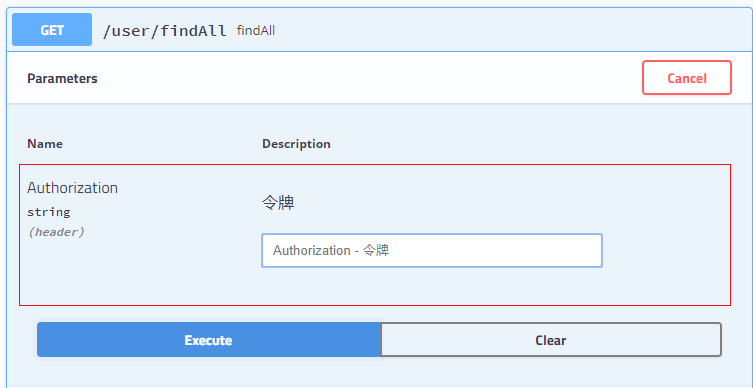
安全配置类
下面这个配置类是Spring Security的关键配置。
在这个配置类中,我们主要做了以下几个配置:
1. 访问路径URL的授权策略,如登录、Swagger访问免登录认证等
2. 指定了登录认证流程过滤器 JwtLoginFilter,由它来触发登录认证
3. 指定了自定义身份认证组件 JwtAuthenticationProvider,并注入 UserDetailsService
4. 指定了访问控制过滤器 JwtAuthenticationFilter,在授权时解析令牌和设置登录状态
5. 指定了退出登录处理器,因为是前后端分离,防止内置的登录处理器在后台进行跳转
WebSecurityConfig.java

package com.louis.springboot.spring.security.config;
import org.springframework.beans.factory.annotation.Autowired;
import org.springframework.context.annotation.Bean;
import org.springframework.context.annotation.Configuration;
import org.springframework.http.HttpMethod;
import org.springframework.security.authentication.AuthenticationManager;
import org.springframework.security.config.annotation.authentication.builders.AuthenticationManagerBuilder;
import org.springframework.security.config.annotation.method.configuration.EnableGlobalMethodSecurity;
import org.springframework.security.config.annotation.web.builders.HttpSecurity;
import org.springframework.security.config.annotation.web.configuration.EnableWebSecurity;
import org.springframework.security.config.annotation.web.configuration.WebSecurityConfigurerAdapter;
import org.springframework.security.core.userdetails.UserDetailsService;
import org.springframework.security.web.authentication.UsernamePasswordAuthenticationFilter;
import org.springframework.security.web.authentication.logout.HttpStatusReturningLogoutSuccessHandler;
import com.louis.springboot.spring.security.security.JwtAuthenticationFilter;
import com.louis.springboot.spring.security.security.JwtAuthenticationProvider;
import com.louis.springboot.spring.security.security.JwtLoginFilter;
/**
* Security Config
* @author Louis
* @date Nov 28, 2018
*/
@Configuration
@EnableWebSecurity
@EnableGlobalMethodSecurity(prePostEnabled = true)
public class WebSecurityConfig extends WebSecurityConfigurerAdapter {
@Autowired
private UserDetailsService userDetailsService;
@Override
public void configure(AuthenticationManagerBuilder auth) throws Exception {
// 使用自定义登录身份认证组件
auth.authenticationProvider(new JwtAuthenticationProvider(userDetailsService));
}
@Override
protected void configure(HttpSecurity http) throws Exception {
// 禁用 csrf, 由于使用的是JWT,我们这里不需要csrf
http.cors().and().csrf().disable()
.authorizeRequests()
// 跨域预检请求
.antMatchers(HttpMethod.OPTIONS, "/**").permitAll()
// 登录URL
.antMatchers("/login").permitAll()
// swagger
.antMatchers("/swagger-ui.html").permitAll()
.antMatchers("/swagger-resources").permitAll()
.antMatchers("/v2/api-docs").permitAll()
.antMatchers("/webjars/springfox-swagger-ui/**").permitAll()
// 其他所有请求需要身份认证
.anyRequest().authenticated();
// 退出登录处理器
http.logout().logoutSuccessHandler(new HttpStatusReturningLogoutSuccessHandler());
// 开启登录认证流程过滤器
http.addFilterBefore(new JwtLoginFilter(authenticationManager()), UsernamePasswordAuthenticationFilter.class);
// 访问控制时登录状态检查过滤器
http.addFilterBefore(new JwtAuthenticationFilter(authenticationManager()), UsernamePasswordAuthenticationFilter.class);
}
@Bean
@Override
public AuthenticationManager authenticationManager() throws Exception {
return super.authenticationManager();
}
}

登录认证触发过滤器
JwtLoginFilter 是在通过访问 /login 的POST请求是被首先被触发的过滤器,默认实现是 UsernamePasswordAuthenticationFilter,它继承了 AbstractAuthenticationProcessingFilter,抽象父类的 doFilter 定义了登录认证的大致操作流程,这里我们的 JwtLoginFilter 继承了 UsernamePasswordAuthenticationFilter,并进行了两个主要内容的定制。
1. 覆写认证方法,修改用户名、密码的获取方式,具体原因看代码注释
2. 覆写认证成功后的操作,移除后台跳转,添加生成令牌并返回给客户端
JwtLoginFilter.java

package com.louis.springboot.spring.security.security;
import java.io.BufferedReader;
import java.io.IOException;
import java.io.InputStream;
import java.io.InputStreamReader;
import java.nio.charset.Charset;
import javax.servlet.FilterChain;
import javax.servlet.ServletException;
import javax.servlet.ServletRequest;
import javax.servlet.ServletResponse;
import javax.servlet.http.HttpServletRequest;
import javax.servlet.http.HttpServletResponse;
import org.springframework.security.authentication.AuthenticationManager;
import org.springframework.security.authentication.event.InteractiveAuthenticationSuccessEvent;
import org.springframework.security.core.Authentication;
import org.springframework.security.core.AuthenticationException;
import org.springframework.security.core.context.SecurityContextHolder;
import org.springframework.security.web.authentication.UsernamePasswordAuthenticationFilter;
import com.alibaba.fastjson.JSON;
import com.alibaba.fastjson.JSONObject;
import com.louis.springboot.spring.security.utils.HttpUtils;
import com.louis.springboot.spring.security.utils.JwtTokenUtils;
/**
* 启动登录认证流程过滤器
* @author Louis
* @date Nov 28, 2018
*/
public class JwtLoginFilter extends UsernamePasswordAuthenticationFilter {
public JwtLoginFilter(AuthenticationManager authManager) {
setAuthenticationManager(authManager);
}
@Override
public void doFilter(ServletRequest req, ServletResponse res, FilterChain chain)
throws IOException, ServletException {
// POST 请求 /login 登录时拦截, 由此方法触发执行登录认证流程,可以在此覆写整个登录认证逻辑
super.doFilter(req, res, chain);
}
@Override
public Authentication attemptAuthentication(HttpServletRequest request, HttpServletResponse response) throws AuthenticationException {
// 可以在此覆写尝试进行登录认证的逻辑,登录成功之后等操作不再此方法内
// 如果使用此过滤器来触发登录认证流程,注意登录请求数据格式的问题
// 此过滤器的用户名密码默认从request.getParameter()获取,但是这种
// 读取方式不能读取到如 application/json 等 post 请求数据,需要把
// 用户名密码的读取逻辑修改为到流中读取request.getInputStream()
String body = getBody(request);
JSONObject jsonObject = JSON.parseObject(body);
String username = jsonObject.getString("username");
String password = jsonObject.getString("password");
if (username == null) {
username = "";
}
if (password == null) {
password = "";
}
username = username.trim();
JwtAuthenticatioToken authRequest = new JwtAuthenticatioToken(username, password);
// Allow subclasses to set the "details" property
setDetails(request, authRequest);
return this.getAuthenticationManager().authenticate(authRequest);
}
@Override
protected void successfulAuthentication(HttpServletRequest request, HttpServletResponse response, FilterChain chain,
Authentication authResult) throws IOException, ServletException {
// 存储登录认证信息到上下文
SecurityContextHolder.getContext().setAuthentication(authResult);
// 记住我服务
getRememberMeServices().loginSuccess(request, response, authResult);
// 触发事件监听器
if (this.eventPublisher != null) {
eventPublisher.publishEvent(new InteractiveAuthenticationSuccessEvent(authResult, this.getClass()));
}
// 生成并返回token给客户端,后续访问携带此token
JwtAuthenticatioToken token = new JwtAuthenticatioToken(null, null, JwtTokenUtils.generateToken(authResult));
HttpUtils.write(response, token);
}
/**
* 获取请求Body
* @param request
* @return
*/
public String getBody(HttpServletRequest request) {
StringBuilder sb = new StringBuilder();
InputStream inputStream = null;
BufferedReader reader = null;
try {
inputStream = request.getInputStream();
reader = new BufferedReader(new InputStreamReader(inputStream, Charset.forName("UTF-8")));
String line = "";
while ((line = reader.readLine()) != null) {
sb.append(line);
}
} catch (IOException e) {
e.printStackTrace();
} finally {
if (inputStream != null) {
try {
inputStream.close();
} catch (IOException e) {
e.printStackTrace();
}
}
if (reader != null) {
try {
reader.close();
} catch (IOException e) {
e.printStackTrace();
}
}
}
return sb.toString();
}
}

登录控制器
除了使用上面的登录认证过滤器拦截 /login Post请求之外,我们也可以不使用上面的过滤器,通过自定义登录接口实现,只要在登录接口手动触发登录流程并生产令牌即可。
其实 Spring Security 的登录认证过程只需 调用 AuthenticationManager 的 authenticate(Authentication authentication) 方法,最终返回认证成功的 Authentication 实现类并存储到SpringContexHolder 上下文即可,这样后面授权的时候就可以从 SpringContexHolder 中获取登录认证信息,并根据其中的用户信息和权限信息决定是否进行授权。
LoginController.java

package com.louis.springboot.spring.security.controller;
import java.io.IOException;
import javax.servlet.http.HttpServletRequest;
import org.springframework.beans.factory.annotation.Autowired;
import org.springframework.security.authentication.AuthenticationManager;
import org.springframework.web.bind.annotation.PostMapping;
import org.springframework.web.bind.annotation.RequestBody;
import org.springframework.web.bind.annotation.RestController;
import com.louis.springboot.spring.security.security.JwtAuthenticatioToken;
import com.louis.springboot.spring.security.utils.SecurityUtils;
import com.louis.springboot.spring.security.vo.HttpResult;
import com.louis.springboot.spring.security.vo.LoginBean;
/**
* 登录控制器
* @author Louis
* @date Nov 28, 2018
*/
@RestController
public class LoginController {
@Autowired
private AuthenticationManager authenticationManager;
/**
* 登录接口
*/
@PostMapping(value = "/login")
public HttpResult login(@RequestBody LoginBean loginBean, HttpServletRequest request) throws IOException {
String username = loginBean.getUsername();
String password = loginBean.getPassword();
// 系统登录认证
JwtAuthenticatioToken token = SecurityUtils.login(request, username, password, authenticationManager);
return HttpResult.ok(token);
}
}

注意:如果使用此登录控制器触发登录认证,需要禁用登录认证过滤器,即将 WebSecurityConfig 中的以下配置项注释即可,否则访问登录接口会被过滤拦截,执行不会再进入此登录接口,大家根据使用习惯二选一即可。
// 开启登录认证流程过滤器,如果使用LoginController的login接口, 需要注释掉此过滤器,根据使用习惯二选一即可
http.addFilterBefore(new JwtLoginFilter(authenticationManager()), UsernamePasswordAuthenticationFilter.class);
如下是登录认证的逻辑, 可以看到部分逻辑跟上面的登录认证过滤器差不多。
1. 执行登录认证过程,通过调用 AuthenticationManager 的 authenticate(token) 方法实现
2. 将认证成功的认证信息存储到上下文,供后续访问授权的时候获取使用
3. 通过JWT生成令牌并返回给客户端,后续访问和操作都需要携带此令牌
SecurityUtils.java

/**
* Security相关操作
* @author Louis
* @date Nov 28, 2018
*/
public class SecurityUtils {
/**
* 系统登录认证
* @param request
* @param username
* @param password
* @param authenticationManager
* @return
*/
public static JwtAuthenticatioToken login(HttpServletRequest request, String username, String password, AuthenticationManager authenticationManager) {
JwtAuthenticatioToken token = new JwtAuthenticatioToken(username, password);
token.setDetails(new WebAuthenticationDetailsSource().buildDetails(request));
// 执行登录认证过程
Authentication authentication = authenticationManager.authenticate(token);
// 认证成功存储认证信息到上下文
SecurityContextHolder.getContext().setAuthentication(authentication);
// 生成令牌并返回给客户端
token.setToken(JwtTokenUtils.generateToken(authentication));
return token;
} ...
}

令牌生成器
我们令牌是使用JWT生成的,下面是令牌生成的简要逻辑,详细参见源码。
JwtTokenUtils.java

/**
* JWT工具类
* @author Louis
* @date Nov 28, 2018
*/
public class JwtTokenUtils implements Serializable {
.../**
* 生成令牌
*
* @param userDetails 用户
* @return 令牌
*/
public static String generateToken(Authentication authentication) {
Map<String, Object> claims = new HashMap<>(3);
claims.put(USERNAME, SecurityUtils.getUsername(authentication));
claims.put(CREATED, new Date());
claims.put(AUTHORITIES, authentication.getAuthorities());
return generateToken(claims);
}
/**
* 从数据声明生成令牌
*
* @param claims 数据声明
* @return 令牌
*/
private static String generateToken(Map<String, Object> claims) {
Date expirationDate = new Date(System.currentTimeMillis() + EXPIRE_TIME);
return Jwts.builder().setClaims(claims).setExpiration(expirationDate).signWith(SignatureAlgorithm.HS512, SECRET).compact();
}
...
}

登录身份认证组件
上面说到登录认证是通过调用 AuthenticationManager 的 authenticate(token) 方法实现的,而 AuthenticationManager 又是通过调用 AuthenticationProvider 的 authenticate(Authentication authentication) 来完成认证的,所以通过定制 AuthenticationProvider 也可以完成各种自定义的需求,我们这里只是简单的继承 DaoAuthenticationProvider 展示如何自定义,具体的大家可以根据各自的需求按需定制。
JwtAuthenticationProvider.java

package com.louis.springboot.spring.security.security;
import org.springframework.security.authentication.UsernamePasswordAuthenticationToken;
import org.springframework.security.authentication.dao.DaoAuthenticationProvider;
import org.springframework.security.core.Authentication;
import org.springframework.security.core.AuthenticationException;
import org.springframework.security.core.userdetails.UserDetails;
import org.springframework.security.core.userdetails.UserDetailsService;
import org.springframework.security.crypto.bcrypt.BCryptPasswordEncoder;
/**
* 身份验证提供者
* @author Louis
* @date Nov 20, 2018
*/
public class JwtAuthenticationProvider extends DaoAuthenticationProvider {
public JwtAuthenticationProvider(UserDetailsService userDetailsService) {
setUserDetailsService(userDetailsService);
setPasswordEncoder(new BCryptPasswordEncoder());
}
@Override
public Authentication authenticate(Authentication authentication) throws AuthenticationException {
// 可以在此处覆写整个登录认证逻辑
return super.authenticate(authentication);
}
@Override
protected void additionalAuthenticationChecks(UserDetails userDetails, UsernamePasswordAuthenticationToken authentication)
throws AuthenticationException {
// 可以在此处覆写密码验证逻辑
super.additionalAuthenticationChecks(userDetails, authentication);
}
}

认证信息获取服务
通过跟踪代码运行,我们发现像默认使用的 DaoAuthenticationProvider,在认证的使用都是通过一个叫 UserDetailsService 的来获取用户认证所需信息的。
AbstractUserDetailsAuthenticationProvider 定义了在 authenticate 方法中通过 retrieveUser 方法获取用户信息,子类 DaoAuthenticationProvider 通过 UserDetailsService 来进行获取, 一般情况,这个 UserDetailsService 需要我们自定义,实现从用户服务获取用户和权限信息封装到 UserDetails 的实现类。
AbstractUserDetailsAuthenticationProvider.java

public Authentication authenticate(Authentication authentication) throws AuthenticationException {
...if (user == null) {
cacheWasUsed = false;
try {
user = retrieveUser(username, (UsernamePasswordAuthenticationToken) authentication);
}
...return createSuccessAuthentication(principalToReturn, authentication, user);
}

DaoAuthenticationProvider.java

protected final UserDetails retrieveUser(String username, UsernamePasswordAuthenticationToken authentication)
throws AuthenticationException {
try {
UserDetails loadedUser = this.getUserDetailsService().loadUserByUsername(username);
return loadedUser;
}
...
}

我们自定义的 UserDetailsService,从我们的用户服务 UserService 中获取用户和权限信息。
UserDetailsServiceImpl.java

package com.louis.springboot.spring.security.security;
import java.util.List;
import java.util.Set;
import java.util.stream.Collectors;
import org.springframework.beans.factory.annotation.Autowired;
import org.springframework.security.core.GrantedAuthority;
import org.springframework.security.core.userdetails.UserDetails;
import org.springframework.security.core.userdetails.UserDetailsService;
import org.springframework.security.core.userdetails.UsernameNotFoundException;
import org.springframework.stereotype.Service;
import com.louis.springboot.spring.security.model.User;
import com.louis.springboot.spring.security.service.UserService;
/**
* 用户登录认证信息查询
* @author Louis
* @date Nov 20, 2018
*/
@Service
public class UserDetailsServiceImpl implements UserDetailsService {
@Autowired
private UserService userService;
@Override
public UserDetails loadUserByUsername(String username) throws UsernameNotFoundException {
User user = userService.findByUsername(username);
if (user == null) {
throw new UsernameNotFoundException("该用户不存在");
}
// 用户权限列表,根据用户拥有的权限标识与如 @PreAuthorize("hasAuthority('sys:menu:view')") 标注的接口对比,决定是否可以调用接口
Set<String> permissions = userService.findPermissions(username);
List<GrantedAuthority> grantedAuthorities = permissions.stream().map(GrantedAuthorityImpl::new).collect(Collectors.toList());
return new JwtUserDetails(username, user.getPassword(), grantedAuthorities);
}
}

一般而言,定制 UserDetailsService 就可以满足大部分需求了,在 UserDetailsService 满足不了我们的需求的时候考虑定制 AuthenticationProvider。
如果直接定制UserDetailsService ,而不自定义 AuthenticationProvider,可以直接在配置文件 WebSecurityConfig 中这样配置。
WebSecurityConfig.java
@Override
public void configure(AuthenticationManagerBuilder auth) throws Exception {
// 指定自定义的获取信息获取服务
auth.userDetailsService(userDetailsService)
}
用户认证信息
上面 UserDetailsService 加载好用户认证信息后会封装认证信息到一个 UserDetails 的实现类。
默认实现是 User 类,我们这里没有特殊需要,简单继承即可,复杂需求可以在此基础上进行拓展。
JwtUserDetails.java

package com.louis.springboot.spring.security.security;
import java.util.Collection;
import org.springframework.security.core.GrantedAuthority;
import org.springframework.security.core.userdetails.User;
/**
* 安全用户模型
* @author Louis
* @date Nov 28, 2018
*/
public class JwtUserDetails extends User {
private static final long serialVersionUID = 1L;
public JwtUserDetails(String username, String password, Collection<? extends GrantedAuthority> authorities) {
this(username, password, true, true, true, true, authorities);
}
public JwtUserDetails(String username, String password, boolean enabled, boolean accountNonExpired,
boolean credentialsNonExpired, boolean accountNonLocked, Collection<? extends GrantedAuthority> authorities) {
super(username, password, enabled, accountNonExpired, credentialsNonExpired, accountNonLocked, authorities);
}
}

用户操作代码
简单的用户模型,包含用户名密码。
User.java

package com.louis.springboot.spring.security.model;
/**
* 用户模型
* @author Louis
* @date Nov 28, 2018
*/
public class User {
private Long id;
private String username;
private String password;
...
}

用户服务接口,只提供简单的用户查询和权限查询接口用于模拟。
UserService.java

/**
* 用户管理
* @author Louis
* @date Nov 28, 2018
*/
public interface UserService {
/**
* 根据用户名查找用户
* @param username
* @return
*/
User findByUsername(String username);
/**
* 查找用户的菜单权限标识集合
* @param userName
* @return
*/
Set<String> findPermissions(String username);
}

用户服务实现,只简单获取返回模拟数据,实际场景根据情况从DAO获取即可。
SysUserServiceImpl.java

@Service
public class SysUserServiceImpl implements UserService {
@Override
public User findByUsername(String username) {
User user = new User();
user.setId(1L);
user.setUsername(username);
String password = new BCryptPasswordEncoder().encode("123");
user.setPassword(password);
return user;
}
@Override
public Set<String> findPermissions(String username) {
Set<String> permissions = new HashSet<>();
permissions.add("sys:user:view");
permissions.add("sys:user:add");
permissions.add("sys:user:edit");
return permissions;
}
}

用户控制器,提供三个测试接口,其中权限列表中未包含删除接口定义的权限('sys:user:delete'),登录之后也将无权限调用。
UserController.java

/**
* 用户控制器
* @author Louis
* @date Oct 31, 2018
*/
@RestController
@RequestMapping("user")
public class UserController {
@PreAuthorize("hasAuthority('sys:user:view')")
@GetMapping(value="/findAll")
public HttpResult findAll() {
return HttpResult.ok("the findAll service is called success.");
}
@PreAuthorize("hasAuthority('sys:user:edit')")
@GetMapping(value="/edit")
public HttpResult edit() {
return HttpResult.ok("the edit service is called success.");
}
@PreAuthorize("hasAuthority('sys:user:delete')")
@GetMapping(value="/delete")
public HttpResult delete() {
return HttpResult.ok("the delete service is called success.");
}
}

登录认证检查过滤器
访问接口的时候,登录认证检查过滤器 JwtAuthenticationFilter 会拦截请求校验令牌和登录状态,并根据情况设置登录状态。
JwtAuthenticationFilter.java

/**
* 登录认证检查过滤器
* @author Louis
* @date Nov 20, 2018
*/
public class JwtAuthenticationFilter extends BasicAuthenticationFilter {
@Autowired
public JwtAuthenticationFilter(AuthenticationManager authenticationManager) {
super(authenticationManager);
}
@Override
protected void doFilterInternal(HttpServletRequest request, HttpServletResponse response, FilterChain chain) throws IOException, ServletException {
// 获取token, 并检查登录状态
SecurityUtils.checkAuthentication(request);
chain.doFilter(request, response);
}
}

SecurityUtils.java

/**
* 获取令牌进行认证
* @param request
*/
public static void checkAuthentication(HttpServletRequest request) {
// 获取令牌并根据令牌获取登录认证信息
Authentication authentication = JwtTokenUtils.getAuthenticationeFromToken(request);
// 设置登录认证信息到上下文
SecurityContextHolder.getContext().setAuthentication(authentication);
}

JwtTokenUtils.java

/**
* 根据请求令牌获取登录认证信息
* @param token 令牌
* @return 用户名
*/
public static Authentication getAuthenticationeFromToken(HttpServletRequest request) {
Authentication authentication = null;
// 获取请求携带的令牌
String token = JwtTokenUtils.getToken(request);
if(token != null) {
// 请求令牌不能为空
if(SecurityUtils.getAuthentication() == null) {
// 上下文中Authentication为空
Claims claims = getClaimsFromToken(token);
if(claims == null) {
return null;
}
String username = claims.getSubject();
if(username == null) {
return null;
}
if(isTokenExpired(token)) {
return null;
}
Object authors = claims.get(AUTHORITIES);
List<GrantedAuthority> authorities = new ArrayList<GrantedAuthority>();
if (authors != null && authors instanceof List) {
for (Object object : (List) authors) {
authorities.add(new GrantedAuthorityImpl((String) ((Map) object).get("authority")));
}
}
authentication = new JwtAuthenticatioToken(username, null, authorities, token);
} else {
if(validateToken(token, SecurityUtils.getUsername())) {
// 如果上下文中Authentication非空,且请求令牌合法,直接返回当前登录认证信息
authentication = SecurityUtils.getAuthentication();
}
}
}
return authentication;
}

接口测试
找到 SpringSecurityApplication, 启动程序, 访问 http://localhost:8080/swagger-ui.html,进入Swagger。
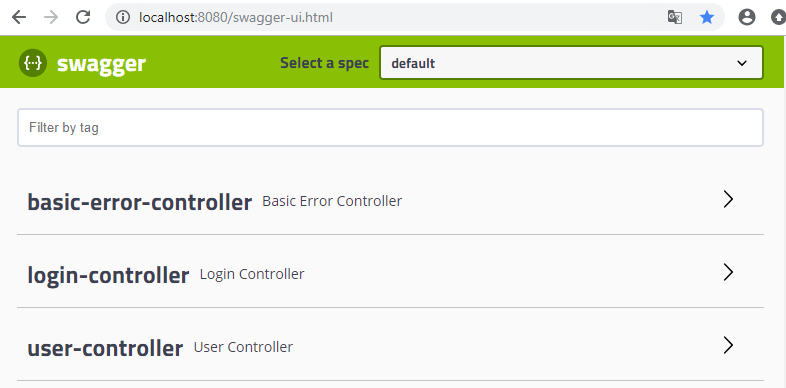
我们先再未登录没有令牌的时候直接访问接口,发现都返回无权限,禁止访问的结果。

返回拒绝访问结果。
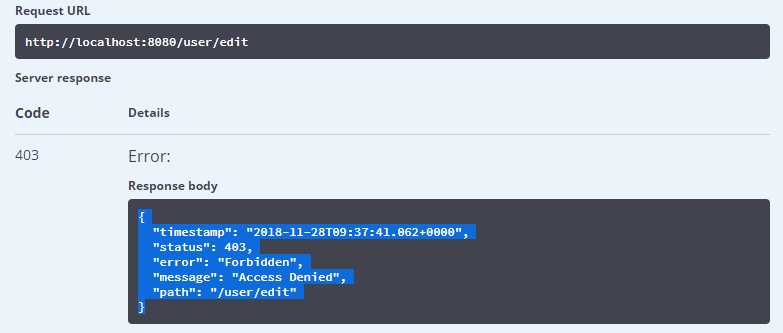
打开 LoginController,输入我们用户名和密码(username:amdin, password:123)
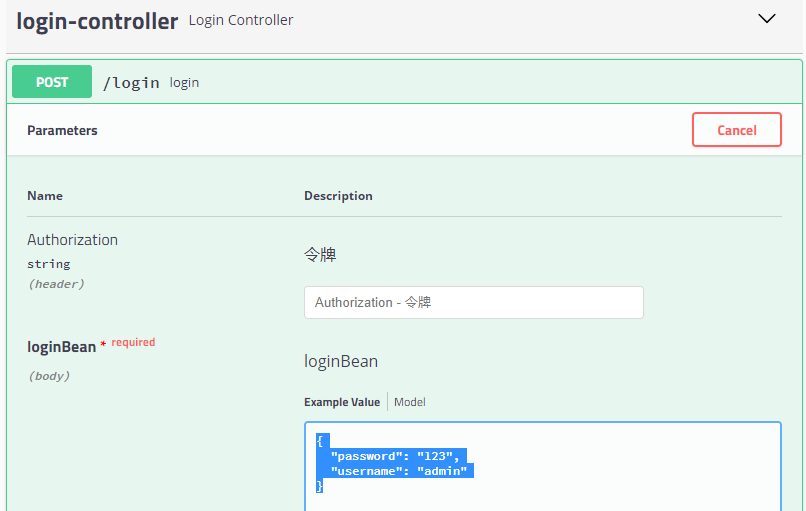
登录成功之后,成功返回令牌,如下图所示。
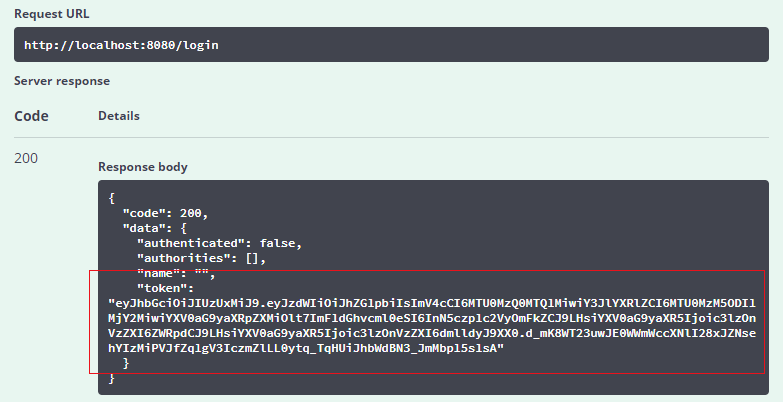
拷贝返回的令牌,粘贴到令牌参数输入框,再次访问 /user/edit 接口。
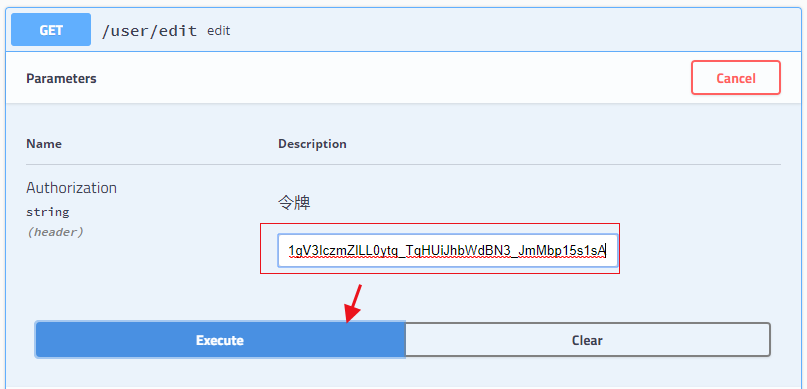
这个时候,成功的返回了结果: the edit service is called success.
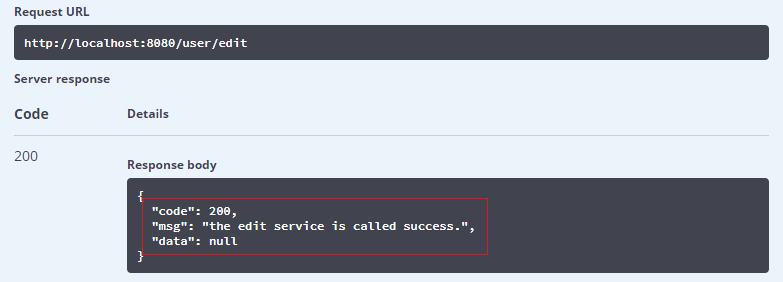
同样的,拷贝返回的令牌,粘贴到令牌参数输入框,访问 /user/delete 接口。
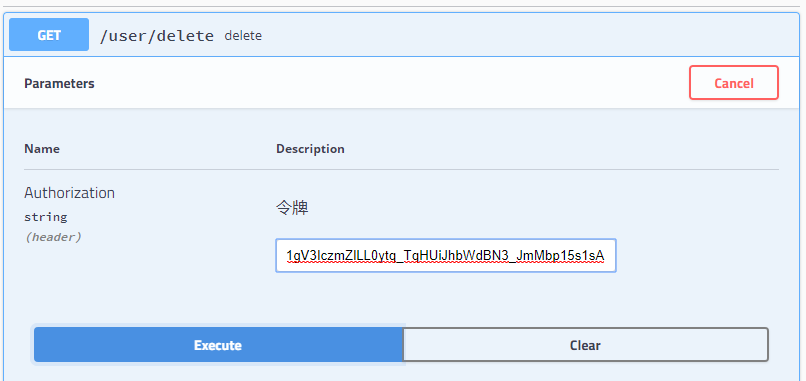
发现还是返回拒绝访问的结果,那是因为访问这个接口需要 'sys:user:delete' 权限,而我们之前返回的权限列表中并没有包含,所以授权访问失败。
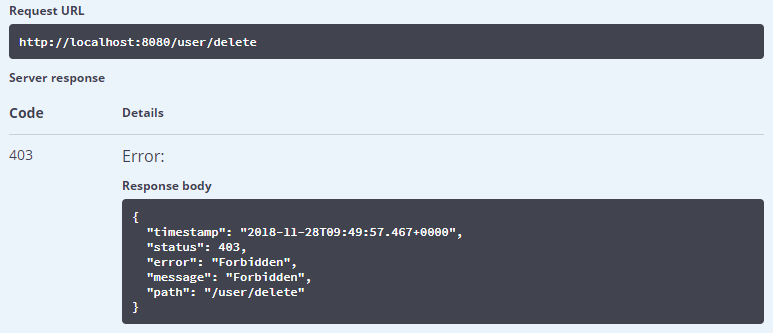
我们修改一下 SysUserServiceImpl,添加上‘sys:user:delete’ 权限,重新登录,再次访问一遍。

发现删除接口也可以访问了,记住务必要重新调用登录接口,获取令牌后拷贝到删除接口,再次访问删除接口。
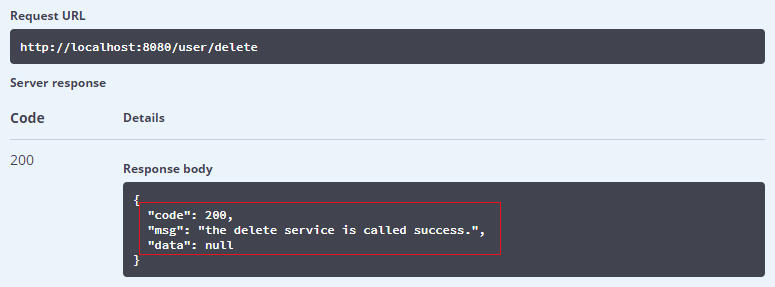
到此,Spring Security 的讲解就结束了,本人知识有限,有不正确的地方,烦请指正,不尽感激。















